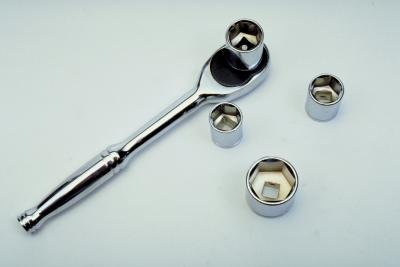
Replacing a radiator drain plug yourself is a simple repair that should take 25 minutes or less to complete. Damage to the radiator drain plug is most often due to wear on the rubber gasket that creates a seal between the plug and radiator. The drain plug can also be damaged from over-tightening during installation.
Pop the hood on your vehicle, then remove the radiator cap and set it aside.
Raise the front end of the vehicle slightly with your car jack. The tires should not leave the ground. The front end of the vehicle should be only high enough to allow the shocks to extend. Slide the jack stand in place to the left of the car jack. Return the locking pin to secure the jack stand's height. If you have an SUV or full-size truck, you do not have to raise the vehicle.
Locate the radiator drain plug at the bottom of your radiator. The drain plug should be in the center or far right lower corner of the radiator. Slide the coolant drain pan into position under the radiator drain plug.
Remove the radiator drain plug slowly with your socket wrench. If your drain plug is winged, you will have to remove it by hand. Make sure the coolant drain pan is in place to catch the coolant as it begins to flow. Allow the coolant to properly drain for 20 to 25 minutes undisturbed.
Inspect your new drain plug to make sure it isn’t damaged. Compare the old drain plug with the new one to make sure the diameters are the same. Your new drain plug should have a rubber gasket. Inspect the gasket to make sure there are no cracks or cuts.
Slide the coolant drain pan out of the way slowly so you don’t spill the discarded coolant. Install the new radiator drain plug. There are no standard torque settings for how tight you should secure the drain plug. Once the plug is hand-tight, an additional ¼ turn will be sufficient. Do not over-tighten the plug, because you risk damaging it and the radiator.
Pour ¼ bottle of new coolant into the radiator using your funnel. Wait 10 minutes while observing the drain plug for signs of leaks. If there are no signs of a leak, properly fill the radiator along with the overflow reservoir, then replace the radiator cap.
Fill the three empty coolant bottles equally with the old coolant. Store the old coolant in a safe location until it can be taken to a recycling center.
Start the vehicle and let it run until it reaches operating temperature. You will know the vehicle is at the right temperature when you’re able to turn on the heat and the air is hot. Check the drain plug again while the engine is running to see if it is leaking. If there are no leaks, turn the engine off.
Remove the jack stand and lower the vehicle’s front end completely. Take the vehicle for a test drive at 45 mph or more for 20 minutes. Check the drain plug one final time with the engine running to assure the repair was completed correctly.